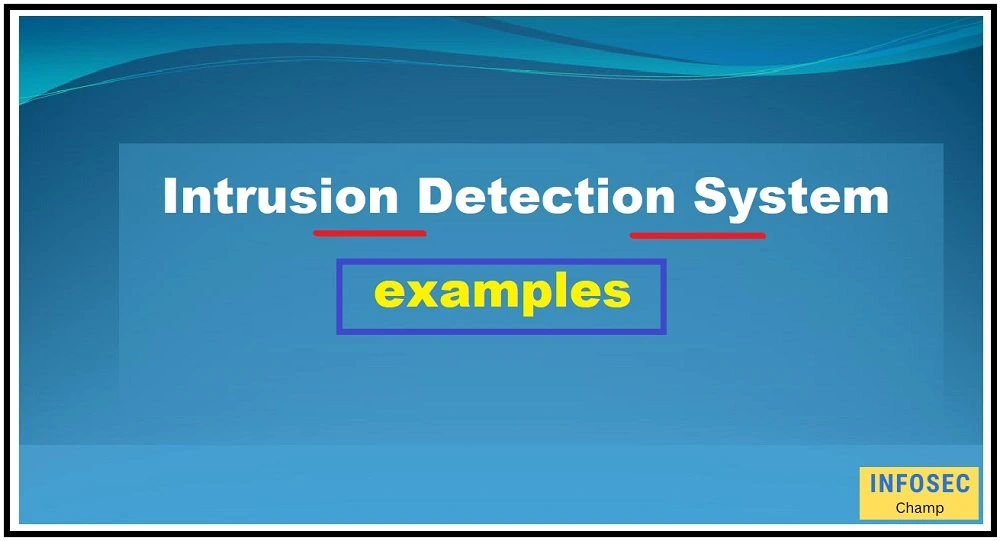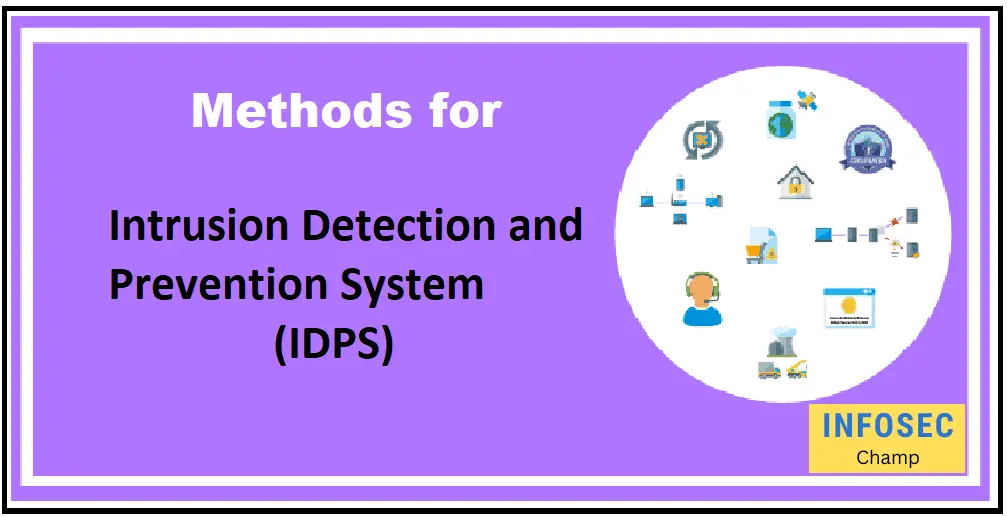Network and system activity is monitored for malicious activity using intrusion detection and prevention systems (IDPS), which can be set up to respond to attacks automatically. Network-based IDPS (NIDPS) and host-based IDPS are the two basic categories that IDPS can be categorized into (HIDPS). All incoming and outgoing network traffic is watched by NIDPS, which functions at the network level, for indications of an attack. HIDPS analyses activity on a single host for indications of an attack at the host level.
Identification and notification of unauthorized access or attacks on a computer system or network is the process of intrusion detection. Identification and defense against unauthorized access to or assaults on a computer system or network is known as intrusion prevention. Incorporating intrusion detection and prevention into a company’s security plan is crucial since it helps guard against online dangers like malware, doS attacks, and unwanted access to systems and data.
How IDPS works?
Intrusion detection and prevention systems (IDPS) can function in a number of different ways.
The use of signature-based detection is one such technique. This method involves configuring the IDPS with a database of known attack signatures, which are patterns of system or network activity connected to particular types of assaults. The IDPS keeps an eye out for certain attack signatures in network or system activity and issues an alarm if it does.
Anomaly-based detection is another way the IDPS operates. With this method, the IDPS is taught to identify typical behavior for a particular system or network. When it notices something that significantly deviates from this regular pattern of activity, which could be an indication of an assault, it then monitors activities and generates an alarm.
Signature-based and anomaly-based detection can also be combined by IDPS (intrusion detection and prevention systems). Some IDPS also use machine learning techniques, enabling them to learn and adjust over time to different kinds of threats.
In addition to detection, IDPS can be set up to respond to threats with automated action. This may entail quarantining the compromised system or affected data, blocking the attack’s origin, or notifying security personnel.
What are the types of intrusion detection systems? | intrusion detection and prevention system in information security | What are the major aspects of intrusion prevention?
In order to monitor network and system activities for malicious behavior, a variety of intrusion detection and prevention systems (IDPS) are available. The followings are the primary IDS and IDPS types:
- Network-based IDS (NIDS): This type of IDS monitors incoming and outgoing network traffic and looks for patterns or anomalies that could indicate an attack.
- Host-based IDS (HIDS): This type of IDS monitors activity on a single host, such as a computer or server, and looks for patterns or anomalies that could indicate an attack.
- Wireless IDS: This type of IDS monitors wireless network traffic and looks for patterns or anomalies that could indicate an attack.
- Network behavior analysis IDS: This type of IDS monitors network traffic and looks for deviations from normal behavior that could indicate an attack.
- Signature-based IDS: This type of IDS is configured with a database of known attack signatures and looks for these patterns in network or system activity.
- Anomaly-based IDS: This type of IDS is trained to recognize normal activity on a system or network and generates an alert when it detects activity that deviates significantly from this normal pattern.
- Stateful protocol analysis IDS: This type of IDS monitors network traffic at the packet level and looks for deviations from the expected behavior of a given protocol.
- Hybrid IDS: This type of IDS combines elements of multiple IDS types, such as signature-based and anomaly-based detection.
What is a network intrusion detection system?
An intrusion detection system that analyses incoming and outgoing network traffic for patterns or anomalies that might point to an assault is known as a network intrusion detection system (NIDS). NIDS protects against a range of cyber threats, including as malware, denial-of-service attacks, and unauthorized access to systems and data by operating at the network level.
NIDS can be set up to identify attacks using a number of techniques, such as network behavior analysis, anomaly-based detection, and signature-based detection. In signature-based detection, the NIDS is set up with a database of acknowledged attack signatures and scans network traffic for these patterns.
When using anomaly-based detection, the network intrusion detection system (NIDS) is trained to recognize typical network traffic patterns and issues an alarm whenever it notices behavior that significantly deviates from this typical pattern. Monitoring network activity and looking for differences from typical behavior that can point to an attack are both parts of network behavior analysis.
To offer a complete security solution for a company’s network, NIDS can be used in conjunction with other security tools like firewalls and antivirus software.
What is a hybrid intrusion detection system?
An intrusion detection system (of intrusion detection and prevention systems) known as a hybrid intrusion detection system (HIDS) includes components from different IDS types, such as signature-based and anomaly-based detection.
In signature-based detection, the HIDS is set up with a database of recognized threat signatures and scans network or system activity for these patterns. When using anomaly-based detection, a system or network’s normal behavior is recognized by the HIDS, which then generates an alarm whenever it notices activity that significantly deviates from this pattern.
A HIDS (for intrusion detection and prevention systems) can offer a more thorough view of a company’s network and system activity and be more effective at identifying threats by combining these two methods.
HIDS can be used to monitor system activity, network traffic, or both, depending on the particular requirements of an organization. They can be used to defend against a range of cyber threats, such as malware, denial-of-service attacks, and illegal access to systems and data. They can be installed at the network level or at the host level.

What are examples of an intrusion detection system?
Some examples of intrusion detection systems (IDS) include:
- Snort: An open-source network-based IDS that can be used to detect a wide range of cyber threats, including malware, denial of service attacks, and unauthorized access to systems and data.
- OSSEC: An open-source host-based IDS that can be used to monitor activity on individual computers or servers and detect patterns or anomalies that could indicate an attack.
- Aircrack-ng: An open-source wireless IDS that can be used to monitor wireless network traffic and detect patterns or anomalies that could indicate an attack.
- Trend Micro: A commercial network-based IDS that uses signature-based and anomaly-based detection to identify a wide range of cyber threats.
- ZScalar Cloud IPS: A commercial network-based IDS that uses a combination of signature-based and behavioral-based detection to identify and protect against cyber threats.
These are but a few of the IDS that are offered. There are other different IDS products available on the market that can be used to defend against a range of cyberthreats, from open-source to commercial.
What is the difference between an intrusion detection system and an intrusion prevention system?
Security software called an intrusion detection system (IDS) watches over network or system activity for malicious activity or policy violations and notifies administrators when it does so. An IDS merely generates an alarm; it does nothing to halt the activity.
A sort of security program known as an intrusion prevention system (IPS) checks network or system activity for malicious behavior or policy violations and takes appropriate action to stop or block the activity. A network traffic blocker, a quarantine for dangerous files, or a system shutdown are just a few examples of the activities an IPS can be set up to perform in response to identified activity.
In conclusion, the primary distinction between an IDS and an IPS is that the former just detects intrusions and issues a warning, whereas the latter detects intrusions and takes steps to stop or block the activity.
What are the types of intrusion? | What are some common types of intrusion?
There are many types of intrusions that can occur, including:
- Unauthorized access: This type of intrusion involves someone accessing a system or network without permission.
- Malware: This type of intrusion involves the use of malicious software, such as viruses, worms, or Trojan horses, to compromise a system or network.
- Denial of service (DoS): This type of intrusion involves flooding a network or system with traffic, making it unavailable to legitimate users.
- Man-in-the-middle (MITM): This type of intrusion involves an attacker intercepting communications between two parties and being able to read, insert, and modify the data being transmitted.
- Phishing: This type of intrusion involves the use of fake emails or websites to trick users into revealing sensitive information, such as passwords or financial details.
- Physical: This type of intrusion involves someone physically accessing a system or network, such as by tampering with hardware or bypassing security controls.
- Insider: This type of intrusion involves someone who has legitimate access to a system or network and uses that access to perform unauthorized activities.
- SQL injection: This type of intrusion involves injecting malicious code into a database through a website’s input fields.
- Cross-site scripting (XSS): This type of intrusion involves injecting malicious code into a website, allowing an attacker to execute code in the victim’s browser.
- Wireless: This type of intrusion involves attacking wireless networks and devices.
What is the difference between a firewall and IPS?
A firewall is a type of security system that regulates network traffic on the basis of set security rules. A firewall may be based on hardware, software, or a combination of the two. A firewall’s main job is to stop any incoming traffic that has not been authorized specifically.
An intrusion prevention system (IPS), also known as an intrusion detection and prevention system, is a category of security software that keeps an eye out for suspicious activity on a network or system and takes appropriate action to stop or block it. A network traffic blocker, a quarantine for dangerous files, or a system shutdown are just a few examples of the activities an IPS can be set up to perform in response to identified activity.
In conclusion, the major distinction between a firewall and an intrusion prevention system (IPS) is that the former is primarily concerned with managing incoming and outgoing traffic, whilst the latter is concerned with identifying and stopping intrusions. An IPS can be seen as a second line of security that is more concentrated on identifying and reacting to particular sorts of malicious activity, whereas a firewall can be seen as the first line of defense against incoming threats.
What are the features of an IPS?
In order to detect and stop security threats, intrusion prevention systems (IPSs) for intrusion detection and prevention systems often incorporate a variety of capabilities. Common characteristics of IPSs include:
- Network traffic analysis: IPSs typically include the ability to monitor network traffic for malicious activity, such as attempts to exploit vulnerabilities, transmit sensitive data, or spread malware.
- Signature-based detection: IPSs often include a database of known malicious activity, or “signatures,” that they can use to identify and block attacks.
- Anomaly-based detection: IPSs may also use machine learning or other techniques to identify patterns of behavior that deviate from normal activity, which may indicate a security threat.
- Protocol analysis: IPSs can analyze the structure and content of network traffic to identify and block attacks that use specific protocols, such as HTTP or FTP.
- Intrusion prevention policies: IPSs typically include the ability to define and enforce policies that dictate how the system should respond to detected threats. For example, an IPS might be configured to block all traffic from a specific IP address or to quarantine a file that is suspected to be malware.
- Integration with other security systems: IPSs may be able to integrate with other security systems, such as firewalls and security information and event management (SIEM) systems, to provide a more comprehensive security solution.
- Management and reporting: IPSs often include features for managing and configuring the system, as well as generating reports on detected threats and system performance.

What methods are used for intrusion prevention?
For intrusion prevention, a variety of techniques are frequently employed, including:
- Signature-based detection: This method involves using a database of known malicious activity, or “signatures,” to identify and block attacks.
- Anomaly-based detection: This method involves using machine learning or other techniques to identify patterns of behavior that deviate from normal activity, which may indicate a security threat.
- Protocol analysis: This method involves analyzing the structure and content of network traffic to identify and block attacks that use specific protocols, such as HTTP or FTP.
- Rule-based detection: This method involves defining rules that specify what activity should be allowed or blocked, and using those rules to identify and prevent security threats.
- Reputation-based detection: This method involves using data about the reputation of specific sources of traffic, such as IP addresses or domain names, to identify and block malicious traffic.
- Sandboxing: This method involves running potentially malicious code in a controlled environment, such as a virtual machine, to observe its behavior and determine whether it is malicious.
In general, intrusion prevention uses a variety of technologies and procedures to spot and stop security risks before they may cause harm.
What are the 3 Ps of security?
Three fundamental security principles are referred to as the “3 Ps”: protection, prevention, and preparation. These ideas are frequently applied as a framework for analyzing and dealing with security-related problems.
- Protection: This principle calls for taking precautions to keep systems and assets safe. This may entail taking steps like setting up firewalls, putting in place access controls, and deploying security software.
- Prevention: Preventing security issues from happening in the first place is part of the prevention principle. This can involve taking steps like risk assessments, security policy and procedure implementation, and personnel education and training.
- Preparation: Being ready to respond to and recover from security events when they do occur is a key component of this idea. This can involve taking steps like creating a response plan, practicing disaster recovery on a regular basis, and keeping backups of important data.
Overall, the three Ps of security stands for a comprehensive approach to security that goes beyond simply safeguarding resources and systems to include actively preventing security incidents, being ready to respond to those that do happen, and recovering from them.
What are the intrusion detection and prevention techniques in Cybersecurity?
Intrusion detection and prevention methods (intrusion detection and prevention systems) can be utilised in cyber security in a variety of ways, such as:
- Signature-based detection: This technique involves using a database of known malicious activity, or “signatures,” to identify and block attacks.
- Anomaly-based detection: This technique involves using machine learning or other techniques to identify patterns of behavior that deviate from normal activity, which may indicate a security threat.
- Protocol analysis: This technique involves analyzing the structure and content of network traffic to identify and block attacks that use specific protocols, such as HTTP or FTP.
- Rule-based detection: This technique involves defining rules that specify what activity should be allowed or blocked, and using those rules to identify and prevent security threats.
- Reputation-based detection: This technique involves using data about the reputation of specific sources of traffic, such as IP addresses or domain names, to identify and block malicious traffic.
- Sandboxing: This technique involves running potentially malicious code in a controlled environment, such as a virtual machine, to observe its behavior and determine whether it is malicious.
- Network-based intrusion prevention: This technique involves monitoring network traffic for malicious activity and taking action to prevent or block it. This can be accomplished through the use of network-based intrusion prevention systems (IPSs) or other security software for network security.
- Host-based intrusion prevention: This technique involves monitoring the activities of individual systems (e.g., servers, desktops, laptops) for malicious activity and taking action to prevent or block it. This can be accomplished through the use of host-based intrusion prevention systems (HIPSs) or other security software.
- User behavior analytics: This technique involves analyzing user behavior to identify anomalies that may indicate a security threat. This can involve analyzing log data, network traffic, and other indicators of activity to identify patterns that may indicate malicious activity.
What is the protocol-based intrusion detection system?
An intrusion detection system (IDS) that analyses network traffic for malicious behavior or rules violations that are specific to particular protocols, such as HTTP or FTP, is known as a protocol-based intrusion detection system (IDS). To find patterns that might point to a security problem, the IDS examines the traffic’s structure and content.
Protocol-based IDSs can be used to identify a range of security risks, including attempts to use a protocol’s security flaws against it, send sensitive information via an insecure channel, or utilize a specific protocol to spread malware.
In order to offer a more complete security solution, protocol-based IDSs can be used in conjunction with other IDS types, such as signature-based IDSs and anomaly-based IDSs. In order to provide a more comprehensive picture of network activity and potential threats, they can also be connected with other security systems, such as firewalls and security information and event management (SIEM) systems.
How do intrusion detection and prevention systems performance monitoring and analysis?
Systems for monitoring and analyzing network or system activity in order to spot and stop security threats are known as intrusion detection and prevention systems (IDPSs). Detection mode or preventive mode are the two usual operating modes for IDPSs.
When in detection mode, the IDPS watches activity for indications of a security threat, such as attempts to take advantage of flaws, send confidential information, or disseminate malware. The IDPS generates a warning when it notices such activity, but it does nothing to stop it. Administrators can then assess the alert and choose the best course of action.
The IDPS analyses activity in the preventive mode for indicators of a security threat and takes appropriate action to stop or restrict the activity. This may entail halting a system, putting a harmful file in quarantine, or stopping network traffic.
IDPSs can monitor and analyze activity using a variety of methods, including rule-based detection, anomaly-based detection, protocol analysis, and signature-based detection. To offer a more complete security solution, IDPSs can be designed to connect with other security systems like firewalls and security information and event management (SIEM) systems.
How is the intrusion detection and prevention systems market?
The development and marketing of security software intended to track and stop security threats are the primary objectives of the intrusion detection and prevention systems (IDPS) market, a subset of the cybersecurity business. Because enterprises are looking for more sophisticated security solutions due to the complexity and sophistication of cyber threats, the IDPS market is expanding.
The IDPS (Intrusion Detection and Prevention System) market is anticipated to increase from $8.2 billion in 2018 to $16.7 billion by 2023, at a compound yearly growth rate of 15.9%, according to a report from MarketsandMarkets. A number of factors, such as the rising adoption of cloud-based IDPS solutions, the rising demand for security solutions that can defend against advanced persistent threats (APTs), and the rising number of cybersecurity-related regulations and compliance requirements are all contributing to this growth.
The market for IDPS (intrusion detection and prevention systems) is quite cutthroat, with many manufacturers providing a wide range of solutions. In the IDPS market, some of the major players include Cisco, Check Point, Fortinet, Zscaler, and NetSkope.
Azure intrusion detection and prevention systems
The cloud computing platform Microsoft Azure provides a variety of security options, such as intrusion detection and prevention systems (IDPS). With the help of network traffic monitoring, Azure IDPS can spot and stop security threats like attempts to take advantage of flaws, send confidential information, or propagate malware.
Azure IDPS employs a number of methods, such as rule-based detection, anomaly-based detection, protocol analysis, and signature-based detection, to track and examine network traffic. In response to threats, it can be set up to perform a number of different tasks, like halting system activity, quarantining malicious files, or stopping network connections.
The Azure Security Center, a centralized platform for controlling and protecting Azure resources, includes Azure IDPS. A variety of security functions are offered by Security Center, such as threat protection, compliance management, and vulnerability evaluation. In order to offer a complete security solution for Azure resources, it also connects with other Azure security products including Azure Firewall and Azure Advanced Threat Protection.
AWS intrusion detection and prevention systems
The cloud computing platform Amazon Web Services (AWS) provides a variety of security options, such as intrusion detection and prevention systems (IDPS). AWS IDPS is made to keep track of network activity and spot and stop security concerns like attempts to take advantage of flaws, provide confidential information, or disseminate malware.
AWS IDPS employs a number of methods, such as rule-based detection, anomaly-based detection, protocol analysis, and signature-based detection, to track and examine network traffic. In response to threats, it can be set up to perform a number of different tasks, like halting system activity, quarantining malicious files, or stopping network connections.
The AWS Security Hub, a centralized platform for managing and securing AWS services, includes AWS IDPS. A variety of security functions are offered by Security Hub, such as threat protection, compliance management, and vulnerability evaluation. In order to offer a complete security solution for AWS resources, it also connects with other AWS security technologies like AWS WAF and AWS GuardDuty.
What are the selection processes for intrusion detection and prevention systems?
Intrusion detection and prevention system (IDPS) selection procedures typically include the following steps:
- Assessing the organization’s security needs: The first step in the selection process is to assess the organization’s security needs and determine what types of threats the IDPS needs to protect against. This will help to narrow down the list of potential IDPS solutions.
- Evaluating vendor offerings: Once the organization’s security needs have been identified, the next step is to evaluate the offerings of different vendors to determine which IDPS solutions are the best fit. This can involve reviewing product features and capabilities, pricing, and customer support.
- Testing the IDPS: It is important to test the IDPS to ensure that it meets the organization’s needs and performs as expected. This can involve setting up a test environment and simulating different types of security threats to see how the IDPS responds.
- Implementing the IDPS: Once the IDPS has been selected and tested, the next step is to implement it within the organization’s systems and networks. This may involve configuring the IDPS, integrating it with other security systems, and training employees on how to use it.
- Monitoring and upkeep of the IDPS: It is crucial to continuously monitor and maintain the IDPS to make sure it continues to operate efficiently and defend the organization against security threats. Reviewing logs, adding new security signatures and rules to the IDPS, and testing the IDPS to make sure it is operating as intended can all be part of this process.

Top 7 benefits of intrusion detection and prevention systems
Organizations can gain from intrusion detection and prevention systems (IDPS) in a number of ways, including:
- Early security threat detection: IDPS can identify and notify administrators of security issues in real time, enabling them to take preventative or mitigating measures.
- Increased defense against sophisticated threats: IDPS employs a number of methods, including signature-based detection and anomaly-based detection, to defend against a variety of security risks, including sophisticated persistent threats (APTs).
- Improved compliance: By providing proof of security controls and keeping an eye out for compliance issues, IDPS can assist firms in meeting regulatory and compliance requirements connected to cybersecurity.
- Enhanced network activity visibility: IDPS can offer thorough insights into network activity, including traffic sources and destinations, protocols used, and data transmitted.
- Reduced danger of data breaches: By detecting threats and blocking malicious traffic, IDPS can reduce the risk of data breaches.
- Improved incident response: IDPS can offer the data and resources required to react to security incidents swiftly and capably.
- Enhanced network efficiency: By preventing malicious traffic and lessening the demand on network resources, IDPS can help to maximize network efficiency.
Top 15 vendors and players for intrusion detection and prevention systems | best intrusion detection and prevention systems
There are several vendors and market participants in the intrusion detection and prevention systems (IDPS) market, including:
- Cisco
- Check Point
- Fortinet
- McAfee
- Symantec
- Trend Micro
- Palo Alto Networks
- Juniper Networks
- FireEye
- AlienVault
- ArcSight (now part of Micro Focus)
- Rapid7
- LogRhythm
- Sourcefire (now part of Cisco)
- Splunk
This list is not all-inclusive because there are many other vendors and competitors in the IDPS market. Enterprises must carefully evaluate the services of several providers in order to choose the best IDPS solution for their unique needs.
Gartner magic quadrant for intrusion detection and prevention systems for 2023 | Magic quadrant for intrusion detection and prevention systems
According to many criteria, Gartner classifies vendors, players, and OEMs into leaders, challengers, niche players, and visionaries in descending order of best to best. There are several manufacturers of intrusion detection and prevention systems on the market, but Garner occasionally offers ratings based on their effectiveness and market share.
You may visit the Gartner website for more info.
What are the roles and responsibilities of intrusion detection and prevention systems manager?
The typical tasks and obligations of an intrusion detection and prevention systems (IDPS) manager are as follows:
- The responsibility for developing, implementing, and maintaining the organization’s IDPS program falls on the shoulders of the IDPS manager (intrusion detection and prevention systems). This entails selecting and putting into use IDPS technology, making policies for their use, and training staff members on how to utilize them
- IDPS manager is in charge of monitoring and reviewing IDPS logs and alerts to identify potential security vulnerabilities and choose the best course of action.
- In the event of a security issue, the manager of the IDPS (Intrusion Detection and Prevention System) is responsible for planning the organization’s response. This entails working with other IT and security teams to carry out an investigation, implement corrective actions, and repair any damaged systems.
- The IDPS manager may be responsible for overseeing interactions with IDPS vendors, including contract negotiations, planning product updates and upgrades, and addressing technical problems.
- Reporting on the IDPS: The IDPS manager may be responsible for generating reports on the IDPS’s efficacy, security incidents, and compliance with rules and regulations.
- Maintaining industry trends: The IDPS manager should keep up with current trends and best practices in the Intrusion Detection and Prevention System area to ensure that the organization’s IDPS (Intrusion Detection and Prevention System) program is effective and up to date. The investigation is reported by IDPS, which also escalates those reports and mitigates them.
FAQ:
1. What is the importance of intrusion detection and prevention system?
Intrusion detection and prevention systems (IDPS) are essential for businesses because they provide a mechanism to recognize and thwart security threats, such as attempts to exploit vulnerabilities, convey sensitive data, or spread malware. IDPS may mitigate the effects of any security events that do occur, in addition to assisting organizations in preventing damage to their assets and systems.
Some specific benefits of IDPS (Intrusion Detection and Prevention System) include the following:
- Security threats can be detected and alerted to administrators in real-time by Intrusion Detection and Prevention System IDPS, allowing them to take action to stop or lessen the threat.
- Increased defense against sophisticated threats: IDPS, Intrusion Detection, and Prevention Systems employ a number of methods, including signature-based detection and anomaly-based detection, to defend against a variety of security risks, including sophisticated persistent threats (APTs).
- Improved compliance: By providing proof of security controls and keeping an eye out for compliance issues, IDPS can assist firms in meeting regulatory and compliance requirements connected to cybersecurity.
- Enhanced network activity visibility: IDPS can offer in-depth insights into network activity, including the traffic’s sources and destinations, the protocols being utilized, and the types of data being transmitted.
- Reduced risk of data breaches: By blocking malicious traffic and warning administrators of potential dangers, IDPS can reduce the risk of data breaches.
2. What is IDS or IDPS and why is IT important?
An Intrusion Detection and Prevention System (IDPS), a type of security software, monitors a system or network activity to look for potential security vulnerabilities. In order to identify patterns or behaviors that might indicate a security issue, IDS analyses activity using a variety of techniques, including rule-based detection, anomaly-based detection, protocol analysis, and signature-based detection.
IDS is essential because it provides a mechanism for businesses to quickly identify security threats and take action to either stop or mitigate the harm. IDS can provide businesses with useful data about network behavior as well as assist them in identifying and repairing vulnerabilities in their systems and networks.
IDS (intrusion detection and prevention systems) are a vital tool that companies may use to protect their assets, systems, and data while also preserving the confidentiality, integrity, and availability of their systems and data.
Most of the topics and facets of intrusion detection and prevention system have been covered in the aforementioned article (IDPS).
Please leave a remark if you have any recommendations, and we’ll be pleased to present a topic that covers the area of information security and cybersecurity.

